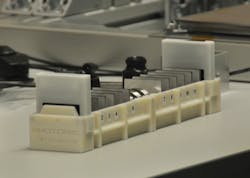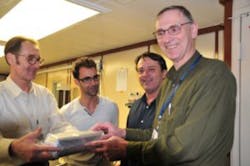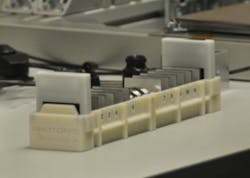High-tech glass plates to help discover the birth of black holes
The University of Leicester is providing a new type of X-ray mirror to the French space agency, CNES, for the Chinese-French satellite SVOM, which is designed to discover and study gamma-ray bursts from newly formed black holes. SVOM will be launched into orbit in 2021.
The mirror will become part of the X-ray telescope, which is essential in precisely locating these new discoveries.
On Dec. 7 there was a formal handover of the delicate and expensive glass components that form part of this mirror by the French team to the University of Leicester, so that the University team can test them and make the first complete version of this mirror.
Professor Julian Osborne, who is leading this work at Leicester, said: “X-rays cannot be reflected like normal light, only at very small angles, so X-ray mirrors have to be made to very high accuracy. Previously this has required very heavy mirrors, but the SVOM satellite cannot carry such a weight. We are making a new type of X-ray mirror, based on the eye of a lobster, which has microscopic square pores with reflecting interior surfaces. This new type of mirror has only a fraction of the weight of previous X-ray mirrors.”
He added, “Gamma-ray bursts are the most luminous explosions in the Universe; they are caused by the death of massive stars and by the collision of two dead neutron stars. Both types of explosion are thought to form a new black hole. The explosions are so bright that they can be seen even from the first few percent of the age of the Universe. Such distant bursts allow us to study the evolution of the Universe, which is otherwise very difficult. Also, the recent discovery of bursts of gravitational waves gives hope that we will discover X-rays from the same colliding dead stars; this would tell us many new details of the make-up of these stars and the nature of the explosion.”
Dr. Jim Pearson from the Department of Physics and Astronomy said, “We are very excited to be starting to build this new mirror. It will be the first lobster X-ray optic to be used in orbit. We have previously used Micro-Pore glass plates from Photonis in France for a different type of X-ray telescope to study the surface of the planet Mercury, so the SVOM X-ray telescope will be built using our earlier experience.”
About the Author

Rick Nelson
Contributing Editor
Rick is currently Contributing Technical Editor. He was Executive Editor for EE in 2011-2018. Previously he served on several publications, including EDN and Vision Systems Design, and has received awards for signed editorials from the American Society of Business Publication Editors. He began as a design engineer at General Electric and Litton Industries and earned a BSEE degree from Penn State.


